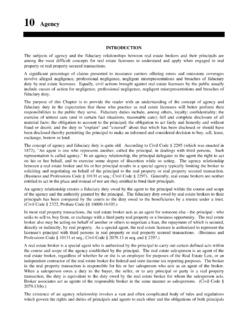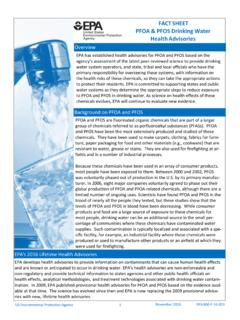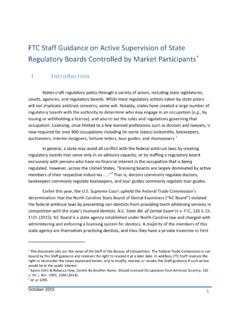Transcription of Toluene - United States Environmental Protection Agency
1 Toluene108-88-3 Hazard SummaryToluene is added to gasoline, used to produce benzene, and used as a solvent. Exposure to Toluene may occurfrom breathing ambient or indoor air affected by such sources. The central nervous system (CNS) is the primarytarget organ for Toluene toxicity in both humans and animals for acute (short-term) and chronic (long-term)exposures. CNS dysfunction and narcosis have been frequently observed in humans acutely exposed to elevatedairborne levels of Toluene ; symptoms include fatigue, sleepiness, headaches, and nausea. CNS depression has beenreported to occur in chronic abusers exposed to high levels of Toluene . Chronic inhalation exposure of humans totoluene also causes irritation of the upper respiratory tract and eyes, sore throat, dizziness, and headache. Humanstudies have reported developmental effects, such as CNS dysfunction, attention deficits, and minor craniofacialand limb anomalies, in the children of pregnant women exposed to high levels of Toluene or mixed solvents byinhalation.
2 EPA has concluded that that there is inadequate information to assess the carcinogenic potential Note: The main sources of information for this fact sheet are EPA's Integrated Risk Information System (IRIS) (2), which contains information on inhalation chronic toxicity of Toluene and the RfC, oral chronic toxicity and the RfD, and the carcinogenic effects of Toluene , and the Agency for Toxic Substances and Disease Registry's(ATSDR's) Toxicological Profile for Toluene . (1)UsesThe major use of Toluene is as a mixture added to gasoline to improve octane ratings. Toluene is also used to produce benzene and as a solvent in paints, coatings, synthetic fragrances, adhesives, inks, and cleaning agents. (1) Toluene is also used in the production of polymers used to make nylon, plastic soda bottles, and polyurethanes and for pharmaceuticals, dyes, cosmetic nail products, and the synthesis of organic chemicals.
3 (1)Sources and Potential ExposureThe highest concentrations of Toluene usually occur in indoor air from the use of common household products (paints, paint thinners, adhesives, synthetic fragrances and nail polish) and cigarette smoke. The deliberate inhalation of paint or glue may result in high levels of exposure to Toluene , as well as to other chemicals, in solvent abusers. (1) Toluene exposure may also occur in the workplace, especially in occupations such as printing or painting, where Toluene is frequently used as a solvent. (1)Automobile emissions are the principal source of Toluene to the ambient air. Toluene may also be released to the ambient air during the production, use, and disposal of industrial and consumer products that contain Toluene . (1)Levels of Toluene m3easured in rural, urban, and indoor air averaged , , and micrograms per cubic meter ( g/m ), respectively.
4 (1)Assessing Personal ExposureToluene and its breakdown products can be detected in the blood or urine to determine whether or notToluene and its breakdown products can be detected in the blood or urine to determine whether or not exposure has occurred. Metabolites measured in the urine are not specific to Toluene , and testing must occur within 12 hours of exposure. (1)Health Hazard InformationAcute Effects:The CNS is the primary target organ for Toluene toxicity in both humans and animals for acute and chronic exposures. CNS dysfunction (which is often reversible) and narcosis have been frequently observed in humans acutely exposed to low or moderate levels of Toluene by inhalation; symptoms include fatigue, sleepiness, headaches, and nausea. CNS depression and death have occurred at higher levels of exposure.
5 (1)Cardiac arrhythmia has also been reported in humans acutely exposed to Toluene . (1)Following the ingestion of Toluene a person died from a severe depression of the CNS. Constriction and necrosis of myocardial fibers, swollen liver, congestion and hemorrhage of the lungs, and tubular kidney necrosis were also reported. (1)Acute exposure of animals to Toluene has been reported to affect the CNS as well as to decrease resistance to respiratory infection. (1)Acute animal tests in rats and mice have demonstrated Toluene to have low acute toxicity by inhalation or oral exposure. (1)Chronic Effects (Noncancer):CNS depression has been reported to occur in chronic abusers exposed to high levels of Toluene . Symptoms include drowsiness, ataxia, tremors, cerebral atrophy, nystagmus (involuntary eye movements), and impaired speech, hearing, and vision.
6 Neurobehavioral effects have been observed in occupationally exposed workers. (1,2)Effects on the CNS have also been observed in studies of animals chronically exposed by inhalation. (1,2) Chronic inhalation exposure of humans to Toluene causes irritation of the upper respiratory tract and eyes, sore throat, dizziness, headache, and difficulty with sleep. (1,2)Inflammation and degeneration of the nasal and respiratory epithelium and pulmonary lesions have been observed in rats and mice chronically exposed to high levels of Toluene by inhalation. (1)Mild effects on the kidneys and liver have been reported in solvent abusers chronically exposed to Toluene vapor. However, these studies are confounded by probable exposure to multiple solvents. (1,2)Slight adverse effects on the liver, kidneys, and lung and high-frequency hearing loss have been reported in some chronic inhalation studies of rodents.
7 (1)The Reference Concentration (RfC) for Toluene is 5 milligrams per cubic meter (5 mg/m3) based on neurological effects in humans. The RfC is an estimate (with uncertainty spanning perhaps an order of magnitude) of a continuous inhalation exposure to the human population (including sensitive subgroups) that is likely to be without appreciable risk of deleterious noncancer effects during a lifetime. It is not a direct estimator of risk but rather a reference point to gauge the potential effects. At exposures increasingly greater than the RfC, the potential for adverse health effects increases. Lifetime exposure above the RfC does not imply that an adverse health effect would necessarily occur. (2)EPA has high confidence in the RfC, the studies on which the RfC was based, and in the overall Toluene database.
8 There are many high quality chronic human studies available including a subset of studies presenting a cluster of NOAELs for neurological effects below reported LOAELs for all available endpoints. In addition, there are numerous supportive animal studies including those showing reproductive and developmental effects at doses higher than that identified as the point of departure. (2)The Reference Dose (RfD) for Toluene is milligrams per kilogram body weight per day ( mg/kg/d) based on increased kidney weight in rats. (2)EPA has medium confidence in the study on which the RfD was based because it was considered an adequate gavage study of subchronic duration. The confidence in the database is also medium because ofa lack of chronic oral data, and a lack of adequate data on endpoints of potential concern for toluenea lack of chronic oral data, and a lack of adequate data on endpoints of potential concern for Toluene including neurotoxicity.
9 For these reasons, there is medium confidence in the RfD. (2)Reproductive/Developmental Effects:CNS dysfunction, attention deficits, minor craniofacial and limb anomalies, and developmental delay were observed in the children of pregnant women exposed to Toluene or to mixed solvents during solvent abuse. Growth retardation and dysmorphism were reported in infants of another study. However, these studies were confounded by exposure to multiple chemicals. (1,2)Children born to Toluene abusers have exhibited temporary renal tubular acidosis. (1)Paternal exposure (in which the mothers had no occupational exposure to Toluene but the fathers did) increased the odds ratio for spontaneous abortions; however, these observations cannot be clearly ascribed to Toluene because of the small number of cases evaluated and the large number of confounding variables.
10 An increased incidence of spontaneous abortions was also reported among occupationally exposed women. However, these studies are not conclusive due to many confounding variables. (1)Several inhalation studies have shown Toluene to be a developmental toxicant, but not a reproductive toxicant, in rodents. (1)Cancer Risk:Available studies in workers have reported limited or no evidence of the carcinogenic potential of Toluene . Similarly, the few available epidemiological studies have failed to demonstrate increased risk of cancer due to inhalation exposure to Toluene . However, these studies were limited due to the size of the study population and lack of historical monitoring data. (1)Chronic inhalation exposure of rats did not produce an increased incidence of treatment-related neoplastic lesions.


















